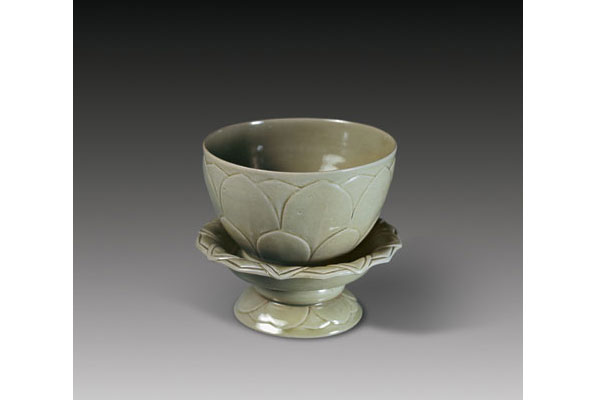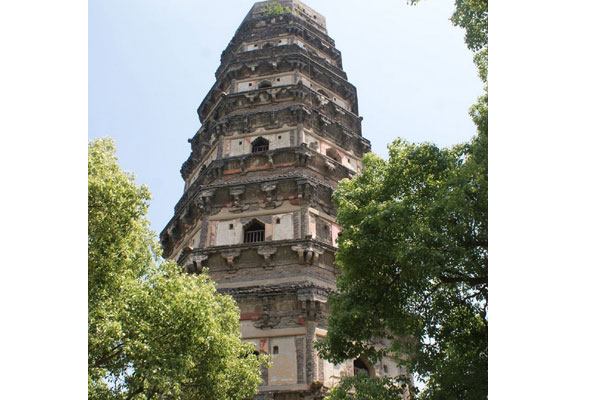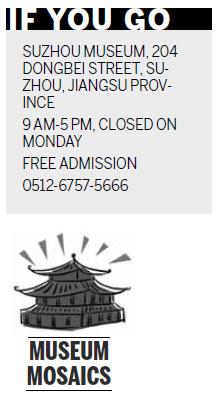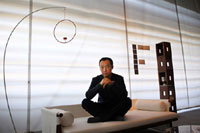'Secret' ceramic
Updated: 2012-12-17 14:08
By Zhang Kun (China Daily)
|
|||||||||||
|
 |
|
The secret-colored ceramic bowl decorated with lotus patterns was unearthed from the Huqiu Pagoda. |
 |
|
The Huqiu Pagoda stands on top of Huqiu, or Tiger Hill, in the suburb of Suzhou. Photos Provided to China Daily |
The legendary 10th century 'secret-colored ceramics' is a fine Suzhou attraction unearthed at Huqiu Pagoda, or Tiger Hill. Zhang Kun reports.
Archeologists were for many years confused about the "secret-colored ceramics" mentioned in poems and prose of the Tang Dynasty (AD 618-907).
Some 20 years have passed since a very fine celadon bowl decorated with lotus patterns was unearthed from the pagoda in suburban Suzhou's Huqiu, or Tiger Hill before experts at Suzhou Museum realized that it was a piece of the legendary "secret-colored ceramic".

The so-called secret-colored ceramic was a very fine porcelain from the ancient kingdom of Yue, or today's Zhejiang province, and made for imperial use only. The recipe of the glaze and baking procedures were kept secret in the Tang Dynasty.
A poem by Lu Guimeng suggests that this type of ceramic has a green glaze like the "essence of trees from a thousand hills". It is said to be colored in a "similar way to Yue celadon, but brighter and lighter".
In 1978, an underground palace was discovered at Famen Temple in today's Shaanxi province, where 13 ceramic ware works were unearthed, together with a written account of the imperial offering that identified them as "secret-colored ceramic".
"It was not until then that we realized the bowl in our museum, unearthed in 1957, was a fine example of the legendary secret-colored ceramic (20 years after its discovery)," says Wang Huixiang, a curator with Suzhou Museum.
The Yunyan Temple Pagoda, commonly known simply as Huqiu Pagoda, was built in 959, and completed in 961. It stands on top of Huqiu, or Tiger Hill, in the northwestern suburb of Suzhou.
Tiger Hill has for centuries been a famous scenic area, and the tower was used for the storage of Buddhist scripts and sacred relics for the Yunyan Temple.
It has been tilting slightly northwest since the 14th century. In 1956, the local government decided to strengthen the main structure to prevent the pagoda from falling down.
"Workers were pouring mud-concrete into the gap between bricks of the second level, and were frustrated because however much they poured, the gap just never filled up," Wang says. "Finally, they removed some bricks to see what was beneath and a tunnel appeared."
The tunnel leads to the heart of the pagoda's second level, where they found a secret chamber and excited archeologists discovered Buddha statues of bronze and stone, iron shrines for sacred relics, as well as well-preserved scripts in stone cases decorated with relief statues of Buddha and cloud patterns.
On the third and fourth levels, similar chambers were found, and more valuable artifacts were discovered.
 |
The lotus bowl was the most precious discovery from the chamber on the third level.
It dates back to the 10th century. It is 8.9 cm high, sitting on a saucer of 6.6 cm. The diameter of the upper rim is 14.9 cm, and the bottom is 9.3 cm. Lotus petals were carved on the outer surface of the bowl and the saucer
"It's an ingenious design, and the bowl looks like a lotus in full blossom," Wang says.
From the unglazed bottom, one can see the piece is made from very fine clay, and this gives the ware a very pure and even texture. The olive-green glaze brings out a warm luster like jade. "It's a national treasure, and typical of the secret-colored ceramic," Wang says
All the important archeological discoveries from the pagoda are exhibited in a special hall at Suzhou Museum.
"We are a much smaller museum compared to those in Beijing, Shanghai and the provincial capital of Nanjing," Wang says. "Many of the more prominent artifacts from around Suzhou are now exhibited in those big museums.
"Discoveries from the ancient pagoda make up an important part of our collection."
The lotus bowl is kept individually in a glass case, taking a central position in the hall.
Restoration of the pagoda of Tiger Hill was completed in 1957, but cracks repeatedly appeared in 1965 and 1977.
Architects found the northeastern foot of the pagoda had collapsed both inside and outside. A more complicated restoration project started in 1981, strengthening the foundation and rebuilding a solid base for the pagoda.
It has been safe and stable since 1986, when the work was completed. Visitors to Tiger Hill will find the pagoda to be one of the main attractions of their tour.
Contact the writer at zhangkun@chinadaily.com.cn
Related Stories
Eat like a local: Suzhou 2012-09-29 12:42
Sweet licks of summer in Suzhou 2012-04-23 10:52
5th China Embroidery Culture and Arts Festival opens in Suzhou 2012-12-03 16:00
Autumn leaves of maidenhair trees in Huqiushan, Suzhou 2012-11-21 15:26
Suzhou embroidery keeps ancient needle art alive 2012-11-15 16:46
Today's Top News
Rescuers race against time for quake victims
Telecom workers restore links
Coal mine blast kills 18 in Jilin
Intl scholarship puts China on the map
More bird flu patients discharged
Gold loses sheen, but still a safe bet
US 'turns blind eye to human rights'
Telecom workers restore links
Hot Topics
Lunar probe , China growth forecasts, Emission rules get tougher, China seen through 'colored lens', International board,
Editor's Picks

|

|

|

|

|

|





